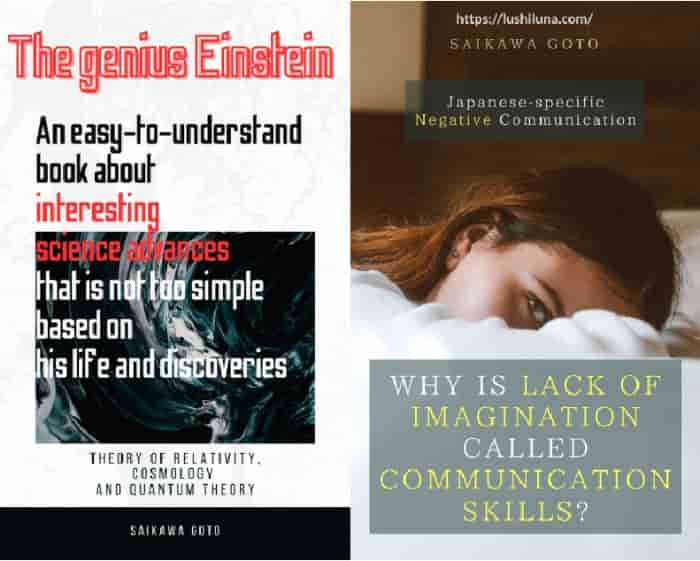I wrote this article in Japanese and translated it into English using ChatGPT. I also used ChatGPT to create the English article title. I did my best to correct any translation mistakes, but please let me know if you find any errors. By the way, I did not use ChatGPT when writing the Japanese article. The entire article was written from scratch by me, Saikawa Goto.
Introduction
Movies and books covered in this article
Three takeaways from this article
- “Superstring Theory” is noted as one of the possibilities to combine “General relativity” and “quantum mechanics.”
- What does “space might be an illusion” mean?
- “Superstring Theory” is a theory that can only be applied to a “9-dimensional space.”
Self-introduction article


Published Kindle books(Free on Kindle Unlimited)
“The genius Einstein: An easy-to-understand book about interesting science advances that is not too simple based on his life and discoveries: Theory of Relativity, Cosmology and Quantum Theory”
“Why is “lack of imagination” called “communication skills”?: Japanese-specific”negative” communication”
The quotes in the article were translated using ChatGPT from Japanese books, and are not direct quotes from the foreign language original books, even if they exist.
The Shock of “Space Might be an Illusion” as Described by the Expert of “Superstring Theory”
Contents of the Book and Structure of This Article
This book is a work that summarizes what “Superstring Theory” is, a cutting-edge theory studied by scientists.


At this point in time, the correctness of the “Superstring Theory” has not been recognized yet. In the first place, some scientists who hold a critical position on the “Superstring Theory” even say that since experimental verification is impossible, it remains in the realm of hypothesis. Because “Superstring Theory” is about a very microscopic area, it may not be possible to verify the various predictions suggested by “Superstring Theory” with experimental devices created by humans.
However, on the other hand, “Superstring Theory” may be an essential theory for a realization that scientists have been eagerly awaiting, which is the fusion of “General relativity” and “quantum mechanics.”

Both theories, General relativity and quantum mechanics, are magnificent theories known as the treasures of 20th century physics. General relativity explains phenomena in environments with very strong gravity, such as celestial bodies, while quantum mechanics explains phenomena on a very small scale, such as atoms.
Sometimes, however, both theories need to be applied simultaneously, such as in the case of “Singularity of Black Holes” or the “early universe,” which are both very small but have a tremendous amount of gravity, requiring the use of both General relativity and quantum mechanics.

However, it is known that when these two theories are applied together, they do not fit together well. Therefore, scientists are eagerly awaiting a “new theory that combines General relativity and quantum mechanics”.
And one of the candidates that may become such a theory is “Superstring Theory”.
The author is at the forefront of this theory, which contains both criticism and potential, and this book presents the author’s knowledge of “Superstring Theory” as an active researcher. This work is not recommended for non-science majors as it is not an easy read, but those who are interested in scientific knowledge should be able to follow along.

In this article, I will only focus on one of the author’s main claims that “space might be an illusion” about the difficult concept of “Superstring Theory.” There are many topics covered in the book, but I will concentrate on the most shocking one.
The meaning of the statement “space might be an illusion” may be confusing at first, but I will explain gradually. I want you to experience the stimulating image of what the “Superstring Theory” suggests about how the world may be.

How “Space” has been Perceived
First, let’s talk about how the perception of “space” has changed in the world of science.

The first to appear is the genius Newton. Newton proposed the idea of “absolute space.” This can be said to be the most familiar way of thinking about “space” when we perceive it.

“Absolute space” is an idea that roughly means “there is a “box” called the universe that is unchanging and motionless.” For example, we meet up with someone such as “assemble at Times Square”. In essence, this means that we specify a certain point on the earth by specifying three elements: latitude, longitude, and height. In other words, we are “specifying a point in the ‘box’ called the universe,” and this cannot be realized without the idea of “absolute space,” which means “unchanging and motionless.”
However, later, the genius Einstein rejected Newton’s “absolute space.” He created the “Theory of relativity” from the idea that “space (and time) is relative” and completely transformed the concept of space (and time) up until that point.

The fact that Einstein denied “absolute space” means that our way of arranging a meeting up with (specifying one point in the “box” of space) is wrong. This is strictly true. However, because Einstein’s claim only appears in cases where the speed is extremely fast, it does not become a phenomenon that can be perceived. Therefore, there is no problem in our daily life.
Now, let’s take a look at what kind of claim Einstein made.

Imagine a situation where Person X is in the audience at Angel Stadium of Anaheim, and Person Y is in a plane flying over the stadium. The plane that Person Y is in flies very fast, for example at 50% of the speed of light. And let’s say that, from the perspective of Person X who is standing still, Person A is on the pitcher’s mound atthe stadium.
According to Newton’s idea of “absolute space,” it would look like Person A is on the pitcher’s mound from the perspective of both Person X and Person Y. This would seem natural to us based on our senses. However, Einstein claimed that this is not the case. While the situation of Person X who is standing still does not change, from the perspective of Person Y who is moving at 50% of the speed of light, it appears that Person A is in a different location (such as the batter’s box) rather than on the pitcher’s mound.
In other words, the information of “where Person A is” depends on “the perspective of the observer.” This may be hard to believe based on our senses, but currently, Einstein’s perspective is considered to be correct. We are not in “an unchanging, stationary space” that Newton claimed, but rather, we live in “a space where the way things appear changes depending on the observer.”

In this way in this book, the author reviews the way that “space” has been understood so far.
Let’s Explain the Meaning of the Sentence “Space Might be an Illusion”
Now, let’s move on to the discussion of the sentence “Space might be an illusion.” You probably don’t understand what this sentence means at first, so I will use an explanation using “temperature” as an example in this article.

For us, “temperature” is something familiar. We see the expected temperature in weather forecasts, and we experience sensations like “cold water” and “a hot pan is hot” on a daily basis.

In the world of science, the indicator “temperature” is also used. The unit “K (Kelvin),” which indicates absolute temperature, is often used rather than the familiar unit “°C,” but “temperature” is treated as something that exists as a matter of course, to the extent that a proper unit exists.
However, “temperature” does not actually exist. It is just something that we humans “feel” exists.

In reality, what we think of as “temperature” is actually just the “average energy of molecules.” While temperature may exist in the macro world (the world we live in), it does not exist in the micro world (the world of atoms and molecules). Instead, there is only the “average energy of molecules” generated by the vibration of molecules.
What exists in the macro world disappears in the micro world. In this book this situation is referred to as an “illusion.”
Not it in this book, but let me give you a more familiar example that I came up with.

On TV the other day, they talked about why all dust is gray. I hadn’t thought about it, but it is indeed a strange story. The small bits of trash that become dust should have different colors, but they all turn gray when they become dust.
The answer seems to be that when various colored trash comes together, it looks gray as if the colors are mixed together. When you look at dust under a microscope, you can see that the trash that makes up dust has various colors like red, blue, and green. However, when it becomes a big mass called “dust,” individual colors disappear, and it all looks gray.

This is the opposite of before, an example where something that exists in the micro world disappears in the macro world. In the case of “”dust, even if there is no gray substance among the dirt that makes up it, it appears gray as a whole, so it can be said that “the gray color of dust is an illusion.”
And the author argues that space may also be an illusion in the same way. Just as “temperature in the macro world” is “the energy of molecules (average) in the micro world” and “gray of dust in the macro world” is “various colors of garbage in the micro world,” there is a possibility that “space in the macro world” is “something in the micro world that we don’t know yet.” Although we don’t know what this “something” is, the author believes that something in the micro world appears as “space” in the macro world.

Why did scientists come to such a way of thinking? Let’s look at that next.
The Two Reasons Why Scientists Came to Think “Space May be an Illusion”
The explanations presented in this book are quite difficult, and even I honestly don’t fully understand them. I’ll try to provide an easy-to-understand explanation to the best of my ability.

The first reason is as follows:
It has been discovered that by gradually increasing the parameters of a theory that holds in 9 dimensions, it continuously changes into a different theory that holds in 10 dimensions.
While the idea of 9 or 10 dimensions may seem a bit unimaginable, I’ll try to explain it using a concrete example. Since it’s difficult to imagine 9 dimensions, let’s consider 2 and 3 dimensions instead.

Let’s take “2D manga” and “3D figure” as an example. Since manga and figures are “different dimensions”, we can’t change a manga into a figure just by modifying it, and vice versa. In other words, it would be impossible to “continuously change manga and figures” if we think about it normally.

However, in the study of “Superstring Theory”, a theory was found in which “by gradually increasing the parameters (elements), we can continuously change to the theory of one higher dimension”. In other words, it means that by gradually increasing an element of thea manga (such as “line thickness”), we can continuously transform it into a figure. In other word, it means that even though the manga is fixed in 2D, by just changing the line thickness, it can be transformed into a 3D figure.

With the discovery of such a theory, it is now thought that “dimension” may not be an essential concept. Because 9-dimensional and 10-dimensional objects are essentially the same, then it might be possible to consider them as such. And since “dimension” is precisely an element that specifies “space”, we may be necessary to change our understanding of “space.”
As a second reason, it is introduced the idea as follow.
“A theory without gravity in 3-dimensional space” and “a theory related to gravity in 9-dimensional space” completely match.

In a slightly different form from before, I can say that this is another example of things that go beyond dimensions being the same.
A similar example is the Black Hole.
The “Black Hole” is naturally a three-dimensional entity, but all information about the “Black Hole” is obtained from the “surface of the Black Hole. Since the “surface of the Black Hole” is two-dimensional, we can conclude the following.

“Black Holes,” which are 3-dimensional celestial bodies, can be described using information that exists in two dimensions.
By applying this idea to another case, it was discovered as follow.
The gravitational phenomenon in three-dimensional space can be described as a phenomenon in two-dimensional space where gravity does not exist.
This is called the “holographic theory of gravity.”
In this way, Superstring theory has led to various discoveries that challenge the idea of “dimensions” that define “space.” This has given rise to the idea that our perception of space as a fundamental concept may not be accurate, and that something else fundamental may be what we perceive as “space” in the macro world.

It may be difficult for you to realize because I can only convey in images (and I can’t say I understand it either), but I would think you will find it a very stimulating idea.
The “Superstring Theory” is the First Theory in Human History that Limits the Dimensions
So far, I’ve talked about the idea that space might be an illusion. Now, I want to shift the discussion to why such an argument is possible in the Superstring Theory.

The main reason for this is that “Superstring Theory” is a theory that limits the dimensions that can be applied to it and has never existed before.
Throughout history, humans have come up with various scientific theories. And it could be “the law of universal gravitation,” “Theory of relativity,” “quantum mechanics,” or anything else, but all of these theories are “applicable to any dimension.”
We live in a 3-dimensional space (when time is included, it becomes a 4-dimensional spacetime, but let’s focus on spatial dimensions only), but for example let’s say there are creatures that live in an “85-dimensional space.” Even there, “the law of universal gravitation,” “Theory of relativity,” and “quantum mechanics” can be applied in the same way.

Then on the other hand, scientists are a species that wants to explain everything about this world, and they even think about things like this:
Why is the world we live in “3-dimensional”?

Scientists don’t want to end the explanation with “it just happened to be that way.” In other word, we might be living in “3 dimensions” just by chance, but they can’t help but wonder if there is some reason behind it.

And one of the reasons why some scientists are interested in the “Superstring Theory” is because it is a theory that limits the dimensions to which it can be applied. Mankind has never before had such a theory in its hands. As a theory with limited applicable dimensions, it is natural to expect that it may help us understand why we live in a 3-dimensional world, among other things.
However, the “Superstring Theory” can only be applied to a “9-dimensional space.” Some may wonder why bother studying a theory that only applies to such a high-dimensional space. Since we live in a 3-dimensional world, shouldn’t we be discarding this theory as irrelevant?

However, scientists think this is not a problem. I won’t (or can’t) explain the specifics, they believe that we actually live in a 9-dimensional space, but due to some reasons, 6 dimensions are curled up and invisible (called “Calabi-Yau spaces”), so we only feel like we live in a 3-dimensional space.
In short, it means that they plan to research focused on the fact that the theory is limited applicable dimensions for now, and put aside the issue of it only being applicable in a 9-dimensional space.
I may not understand it at the same level as scientists do, but I also feel that the fact that this is the first theory with limited applicable dimensions is very important.

Rough History of Superstring Theory
The author explains that although there are many researchers studying Superstring Theory today, it had a long period of being overlooked. It seems that in the field of particle physics, the dominant theory was called “field theory,” and Superstring Theory could not become mainstream.
However, a physicist named Schwarz, who was once a colleague of the author, decided to dedicate his life to Superstring Theory and worked tirelessly to keep the flame of this theory alive. Thanks to his efforts, a great discovery was made later, and Superstring Theory was revived, according to the author.

“Superstring Theory” is developed from “string theory”. Although I have not explained so far, “string theory” is a theory that takes the following ideas as its starting point.
Particles are viewed not as “0-dimensional points” but as “1-dimensional strings”.

In school, we learn about “atoms” as if they were tiny “dots”. However, in “string theory”, things that appear as “dots” are actually “rubber-band-like strings” that vibrate. Using this concept, scientists attempt to solve problems that could not be explained before.

However, “string theory” had a big problem. In the world of particle physics, two types of quarks, “Fermions” and “Bosons,” exist, but only “Bosons” can be created based on “string theory’s” concept.

However, later on, the idea of “thinking about string theory within ‘Hyperspace'” emerged. This made it possible to produce both “Fermion” and “Boson” quarks and allowed the theory to survive as a valid explanation.
“Superstring Theory” has developed in such a way, but surprisingly, it was Nambu Yoichiro who created “String Theory,” which is the base of “Superstring Theory.

It is said that he was a genius with a “magical idea,” and his creation of “spontaneous symmetry breaking” was a stunning idea that changed the course of physics. But that’s not all, he also created the “String Theory,” which serves as the basis for “Superstring Theory,” and had many other achievements. He was truly a scientist ahead of his time, and his genius is something that we can appreciate even now.
Conclusion
Currently, I don’t know how “Superstring Theory” will develop in the future. It may be seen as a treasure of 21st-century physics like the Theory of relativity and quantum mechanics, or it may be seen as mere speculation that cannot be verified by experiments and be dismissed.

Published Kindle books(Free on Kindle Unlimited)
“The genius Einstein: An easy-to-understand book about interesting science advances that is not too simple based on his life and discoveries: Theory of Relativity, Cosmology and Quantum Theory”
“Why is “lack of imagination” called “communication skills”?: Japanese-specific”negative” communication”








コメント